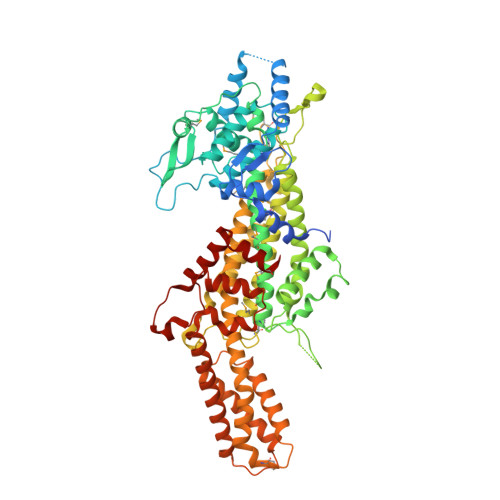Crystal structure of phenylalanine ammonia lyase: multiple helix dipoles implicated in catalysis.
Calabrese, J.C., Jordan, D.B., Boodhoo, A., Sariaslani, S., Vannelli, T.(2004) Biochemistry 43: 11403-11416
- PubMed: 15350127
- DOI: https://doi.org/10.1021/bi049053+
- Primary Citation of Related Structures:
1T6J, 1T6P - PubMed Abstract:
The first three-dimensional structure of phenylalanine ammonia lyase (PAL) has been determined at 2.1 A resolution for PAL from Rhodosporidium toruloides. The enzyme is structurally similar to the mechanistically related histidine ammonia lyase (HAL), with PAL having an additional approximately 160 residues extending from the common fold. We propose that catalysis (including lowering the pK(a) of nonacidic C3 of l-phenylalanine for an E1cb mechanism) is potentially governed by dipole moments of seven alpha helices associated with the PAL active site (six positive poles and one negative pole). Cofactor 3,5-dihydro-5-methylidene-4H-imidazol-4-one (MIO) resides atop the positive poles of three helices, for increasing its electrophilicity. The helix dipoles appear fully compatible with a model of phenylalanine docked in the active site of PAL having the first covalent bond formed between the amino group of substrate and the methylidene group of MIO: 12 highly conserved residues (near the N termini of helices for enhancing function) are poised to serve roles in substrate recognition, MIO activation, product separation, proton donation, or polarizing electrons from the phenyl ring of substrate for activation of C3; and a highly conserved His residue (near the C terminus of the one helix that directs its negative pole toward the active site to increase the residue's basicity) is positioned to act as a general base, abstracting the pro-S hydrogen from C3 of substrate. A similar mechanism is proposed for HAL, which has a similar disposition of seven alpha helices and similar active-site residues. The helix dipoles appear incompatible with a proposed mechanism that invokes a carbocation intermediate.
Organizational Affiliation:
DuPont Central Research and Development, Experimental Station, Wilmington, Delaware 19880-0228, USA. joseph.c.calabrese@usa.dupont.com

















